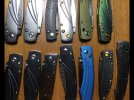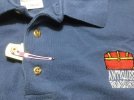Do you consider yourself fairly knowledgeable in cutlery, particularly metallurgical aspects of Japanese cutlery? If so, I have some questions for you:
1. Why are all kitchen knives made of SRS13 or SRS15 alloys clad in much softer SUS405 stainless steel? For a couple of weeks, I've been hunting around for a nakiri made of either SRS13 or SRS15. Every such nakiri was found to be clad in much softer stainless steel. Isn't SRS15 hard and tough enough to stand on its own? It is considered to be a fully stainless steel. Why would it need to be protected by another stainless steel? If the cutting core was made of something more corrosion-prone such as YXR7, then I can understand the reason behind the cladding. SRS15 is also considered to be a tough material, much tougher than ZDP189 so it's not like there's a much risk of chipping. So again, why the clad?
2. What exactly is the difference, if any, between SUS405 vs ANSI405? Are they both same stainless steel but made by the same/different manufacturers under different standards?
3. Has anyone here been crazy enough to own or have had experience with kitchen knives made of ZDP189? While I was searching for SRS15 nakiri, I did happen to come across several sites selling cutlery made of ZDP189. ZDP189 is a fine steel, but it's only a semi-stainless steel at best. And using it for food prep seems ... questionable, especially given the relative instability of ZDP189 edge at acute angles. ZDP189 also stains very easily from handling anything even remotely acidic. Vulnerability to acid is ZDP189's Achilles' heel. Knowing this, why would anyone be crazy enough to sell cutlery made of ZDP189??
Editor's Note: If you're crazy enough to make one, there'll always be someone who's crazy enough to buy it.
1. Why are all kitchen knives made of SRS13 or SRS15 alloys clad in much softer SUS405 stainless steel? For a couple of weeks, I've been hunting around for a nakiri made of either SRS13 or SRS15. Every such nakiri was found to be clad in much softer stainless steel. Isn't SRS15 hard and tough enough to stand on its own? It is considered to be a fully stainless steel. Why would it need to be protected by another stainless steel? If the cutting core was made of something more corrosion-prone such as YXR7, then I can understand the reason behind the cladding. SRS15 is also considered to be a tough material, much tougher than ZDP189 so it's not like there's a much risk of chipping. So again, why the clad?
2. What exactly is the difference, if any, between SUS405 vs ANSI405? Are they both same stainless steel but made by the same/different manufacturers under different standards?
3. Has anyone here been crazy enough to own or have had experience with kitchen knives made of ZDP189? While I was searching for SRS15 nakiri, I did happen to come across several sites selling cutlery made of ZDP189. ZDP189 is a fine steel, but it's only a semi-stainless steel at best. And using it for food prep seems ... questionable, especially given the relative instability of ZDP189 edge at acute angles. ZDP189 also stains very easily from handling anything even remotely acidic. Vulnerability to acid is ZDP189's Achilles' heel. Knowing this, why would anyone be crazy enough to sell cutlery made of ZDP189??
Editor's Note: If you're crazy enough to make one, there'll always be someone who's crazy enough to buy it.
Last edited:




